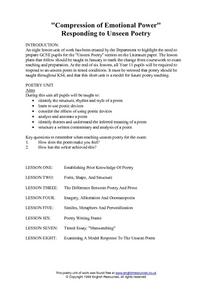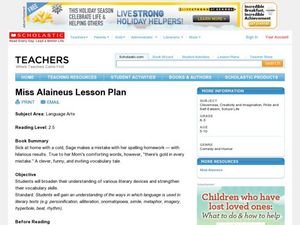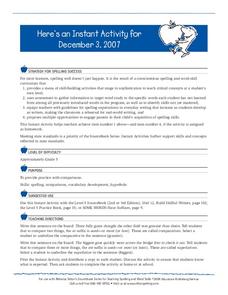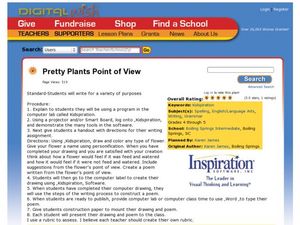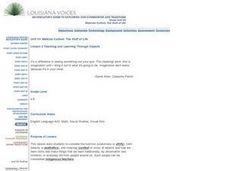Curated OER
Reading Examples
Young writers read excerpts from Gary Paulsen's memoir to identify figurative and literal language that contain sensory details. They determine which selections are examples of sensory language and fi the language is used literally or...
Curated OER
"Compression of Emotional Power"--Responding To Unseen Poetry
Eleventh graders identify the structure, rhythm and style of a selected poem, experience utilizing poetic devices and analyze an annotated poem. They evaluate the themes and inferred meanings to a variety of poems from their textbooks.
Curated OER
Miss Alaineus Lesson Plan
Students gain an understanding of various literary devices and strengthen their vocabulary. In this Miss Alaineus lesson plan, students read the vocabulary tale, discuss the use of literary devices and choose from 4 possible culminating...
Curated OER
Resistance Poetry
Students create a definition for the term resistance. Once a definition has been created, they create a visual image to correlate with their definition. Working in groups, students read several different resistance poems and classify...
Curated OER
Oliver/Kenyon
Learners, through two pieces of writing, identify poetic/language devices through the speakers, personification , imagery, metaphor, etc. They assess the patterns those devices are used in and analyze the theme of each. Each student...
Curated OER
Assembling A Story
Students observe, discuss, and interpret Radcliffe Bailey's work "By the River" by creating a personal narrative of the 18th or 19th century. Internet access is required and related links are offered for teaching aides.
Curated OER
Sleuthing A Writer's Skills
Students read The Train Ride Home by Robin Solomon. In this literature response lesson, students will inspect the writing of Solomon to determine how she established a certain tone through her word choice and...
Curated OER
Comparisons
Fifth graders complete a worksheet. In this comparison lesson, 5th graders view sentences and identify the comparatives in them. Students complete a worksheet on comparisons.
Curated OER
Political Cartoons
Students examine a variety of historical cartoons. They recognize a political cartoon and identify the main idea, symbolism, exaggeration and caricature in political cartoons. Students analyze a political cartoon by Benjamin Franklin.
Curated OER
Making Inferences While Identifying Similes and Metaphors
Use this lesson to study similes and metaphors and the inferred meaning. In this language arts lesson, 5th graders write their own similes and metaphors. A worksheet is provided for extension work or to check understanding as homework.
Curated OER
Allusions to Shakespeare in Popular Culture
Send your high schoolers on a scavenger hunt through popular culture (music, television, video games, movies) to find allusions to Shakespeare. They must each provide three to share with the class, and the one they present cannot have...
Curated OER
Symbols and the Choices we Make
Upper elementary and middle schoolers recognize symbols that influence the choices that we make consciously or unconsciously in everyday life. They look at the symbols and choices that others make. They identify and apply knowledge of...
Curated OER
Pretty Plants Point of View
Young poets use Kidspiration to draw a flower, personify the flower, and write a poem from the flower's point of view. Sharing these poems in small groups will reinforce learners' knowledge of personification.
Curated OER
Similes with Energy
Fifth graders write or dance a simile to show the relationship between two unlike nouns. In this simile and grammar lesson, 5th graders explore dance movements and identify smooth and sharp energy examples. Students review...
Curated OER
Irony in Poetry and Prose (Fiction and Non-fiction Texts)
Middle and high schoolers examine the impact of irony in poetry and prose. In this figurative language lesson, they read instructor-selected literature and identify uses of irony. Then they discuss how irony enhances literature.
Pearson
Lesson Plan: Introduction to Plato’s Cave
Can we perceive reality or are we chained by preconceptions that limit our vision? Plato’s allegory “The Cave” serves to introduce nascent philosophers to Plato’s dialogues and hopefully to engender a love of ideas and discourse. A...
Curated OER
Energy Crisis: Then and Now
Using political cartoons, scholars analyze the energy crisis of the 1970s and '80s, comparing and contrasting it to current tensions with oil. Display the 6 cartoons (linked) to the class, and demonstrate analysis using the worksheet...
Curated OER
Vetern's Day, A Chance to Honor Those Who Served Our Country
Students examine some of the symbols, songs, and pledges that represent our country as well as the liberties they enjoy today due to those who served. They discuss the rules for displaying the United States Flag, practice folding the...
Shmoop
ELA.CCSS.ELA-Literacy.RL.9-10.9
As the saying goes: there are no new stories. Standard 9 for reading literature in the Common Core addresses this fact and requires that students be able to analyze how authors use the themes, stories, and characters of earlier works....
August House
The Contest Between the Sun and the Wind
Learn the moral of the story with a series of activities about Aesop's fables. Focusing on The Contest Between the Sun and the Wind, learners complete a graphic organizer to discuss who, what, how, and why the events occur. Additionally,...
Curated OER
Awesome Animals
Sixth graders write descriptive narratives about animals. In this descriptive writing instructional activity, the teacher models how to write a paragraph with interesting sensory words and exciting verbs. Students choose a picture of an...
Curated OER
Teaching and Learning Through Objects
Students identify and interpret the function, usefulness or utitlity, form, beauty or aesthetics, and meaning, context or story, of objects and how they learn new skills and make things that they learn traditionally, by observation and...
Curated OER
My Favorite Holiday
Students create a My Favorite Holiday Calendar Page. They recall the months of the year and identify the various components of a calendar. Students also apply their learning about holiday customs to consider their own favorite holiday...
Curated OER
Reading the Play
Students read the play "Julius Caesar" by William Shakespeare. In groups, they identify the instances of similes, metaphors and personification. They use the Internet to compare and contrast the events in the play with historical facts....

